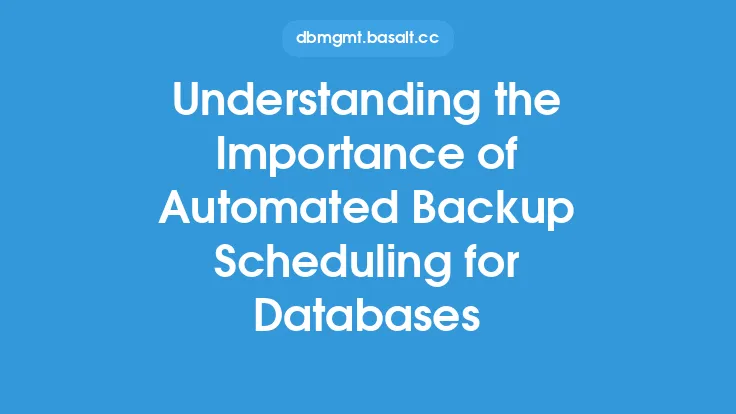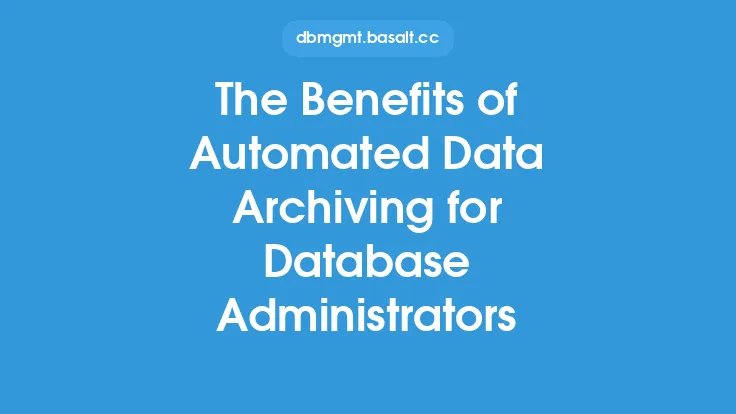Database management is a critical aspect of any organization, as it ensures the integrity, availability, and security of data. One of the most important aspects of database management is backup and recovery, which involves creating copies of data to prevent loss in case of failures or disasters. Manual backup processes can be time-consuming, prone to errors, and may not provide the required level of data protection. This is where automated backup scheduling comes into play, offering a reliable and efficient way to manage database backups.
What is Automated Backup Scheduling?
Automated backup scheduling is a process that allows database administrators to schedule backups to run automatically at specified intervals, without the need for manual intervention. This can be done using specialized software or tools that are designed to manage database backups. Automated backup scheduling provides a number of benefits, including improved data protection, reduced administrative workload, and increased efficiency.
Benefits of Automated Backup Scheduling
The benefits of automated backup scheduling are numerous. Firstly, it ensures that backups are created regularly, without the need for manual intervention. This reduces the risk of data loss, as backups are created automatically, even if the database administrator is not available. Automated backup scheduling also reduces the administrative workload, as database administrators do not need to spend time creating backups manually. This allows them to focus on other critical tasks, such as database maintenance and optimization.
Key Features of Automated Backup Scheduling
Automated backup scheduling typically includes a number of key features, such as scheduling, backup options, and notification. Scheduling allows database administrators to specify when backups should be created, and how often. Backup options provide the ability to customize the backup process, such as selecting which data to backup, and where to store the backups. Notification features alert database administrators when backups are completed, or if any errors occur during the backup process.
Types of Automated Backup Scheduling
There are several types of automated backup scheduling, including full backups, incremental backups, and differential backups. Full backups involve creating a complete copy of the database, while incremental backups involve creating a copy of only the data that has changed since the last backup. Differential backups involve creating a copy of all the data that has changed since the last full backup. Each type of backup has its own advantages and disadvantages, and the choice of which to use depends on the specific needs of the organization.
Best Practices for Implementing Automated Backup Scheduling
To get the most out of automated backup scheduling, there are several best practices that should be followed. Firstly, database administrators should ensure that backups are stored in a secure location, such as an offsite data center or cloud storage. This ensures that backups are protected from physical disasters, such as fires or floods. Database administrators should also ensure that backups are tested regularly, to ensure that they can be restored in case of a disaster. Additionally, database administrators should consider using encryption to protect backups from unauthorized access.
Common Challenges and Limitations
While automated backup scheduling provides a number of benefits, there are also some common challenges and limitations. One of the main challenges is ensuring that backups are completed successfully, without any errors. This can be due to a number of factors, such as network connectivity issues, or problems with the backup software. Another challenge is ensuring that backups are stored securely, and are protected from unauthorized access. To overcome these challenges, database administrators should ensure that they have a robust backup strategy in place, and that they are using reliable backup software.
Future of Automated Backup Scheduling
The future of automated backup scheduling is likely to involve increased use of cloud-based backup solutions, and greater integration with other database management tools. Cloud-based backup solutions provide a number of benefits, including scalability, flexibility, and cost-effectiveness. Greater integration with other database management tools will also provide a more streamlined and efficient backup process, and will allow database administrators to manage backups from a single console.
Conclusion
In conclusion, automated backup scheduling is a critical aspect of database management, providing a reliable and efficient way to manage database backups. The benefits of automated backup scheduling include improved data protection, reduced administrative workload, and increased efficiency. By following best practices, and using reliable backup software, database administrators can ensure that their backups are completed successfully, and that their data is protected from loss or corruption. As technology continues to evolve, it is likely that automated backup scheduling will become even more sophisticated, providing greater levels of automation, and increased integration with other database management tools.





